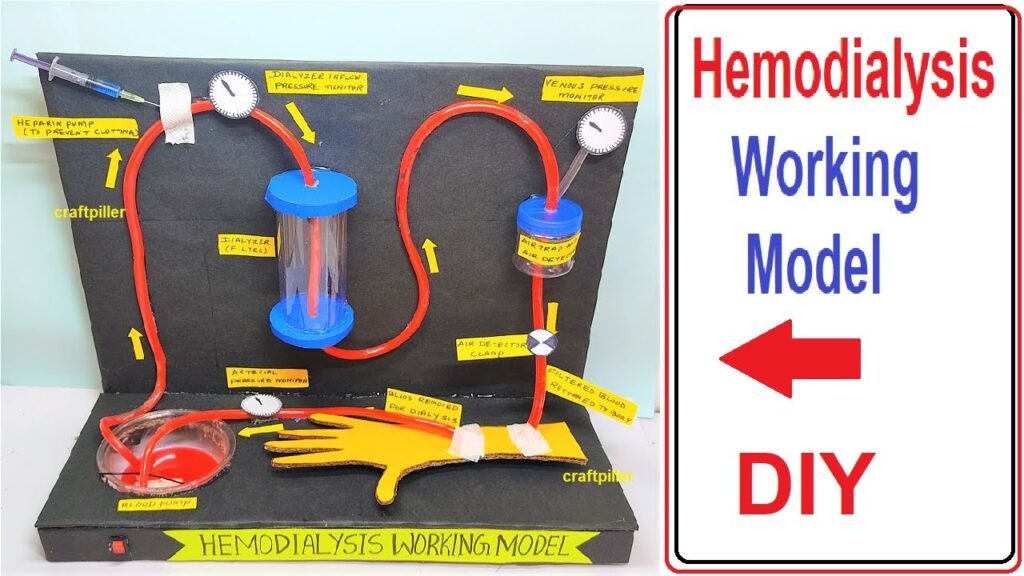Hemodialysis and Artificial Kidney Introduction:
Hemodialysis:
Hemodialysis is a medical procedure used to remove waste products and excess fluids from the blood when the kidneys are unable to perform these functions adequately.
This therapy is crucial for individuals with kidney failure or impaired kidney function.
Hemodialysis helps maintain a balance of electrolytes and fluid in the body, regulating blood pressure and preventing the buildup of harmful substances.
Artificial Kidney:
An artificial kidney, also known as a hemodialyzer, is a key component of the hemodialysis process. It mimics the essential functions of a natural kidney by filtering the patient’s blood to remove waste and excess fluids.
The artificial kidney consists of a semipermeable membrane that allows the exchange of substances between the patient’s blood and a special dialysis solution.
Components and Process:
- Dialyzer:
- The dialyzer, or artificial kidney, contains two compartments separated by the semipermeable membrane. One compartment allows the flow of the patient’s blood, while the other contains the dialysis solution.
- Blood Circulation:
- The patient’s blood is pumped into the dialyzer, where it comes into contact with the membrane. Small molecules, toxins, and excess fluids pass through the membrane into the dialysis solution, which is later discarded.
- Dialysis Solution:
- The dialysis solution, or dialysate, is carefully formulated to facilitate the removal of waste products. It contains electrolytes and other components to create an osmotic gradient for the movement of substances across the membrane.
- Filtration and Cleansing:
- As blood circulates through the dialyzer, waste products, toxins, and excess fluids move from the patient’s blood through the membrane into the dialysis solution. This process effectively cleanses the blood.
- Cleaned Blood Return:
- After filtration, the cleaned blood is returned to the patient’s circulation. The entire process is typically performed over several hours during a hemodialysis session, which may occur several times a week.
Working model of a hemodialysis model making
Creating a working model of a hemodialysis artificial kidney involves simplifying the complex processes involved in real-life hemodialysis machines.

Here’s a step-by-step guide to making a basic, educational model:
Materials Needed:
- Plastic container (to represent the body)
- Plastic tubing
- Clear plastic bag (to simulate a blood vessel)
- Sponge or absorbent material
- Small plastic cups
- Water
- Red food coloring (to represent blood)
- Blue food coloring (to represent dialysate)
- Plastic or rubber gloves
- Craft or utility knife
- Glue or adhesive
- Marker
Video Step by Step Instructions of Hemodialysis working model :
1. Container Setup:
- Take the plastic container to represent the body. Cut a small opening near the bottom using the craft knife. This will be the entry point for the blood vessel.
2. Blood Vessel Simulation:
- Fill a clear plastic bag with water and add a few drops of red food coloring to simulate blood. Seal the bag tightly and attach it to the entry point on the container using plastic tubing. This represents the blood vessel.
3. Dialysis Membrane:
- Place a sponge or absorbent material inside the container near the entry point. This will act as the artificial kidney’s dialysis membrane.
4. Dialysate Setup:
- Fill small plastic cups with water and add a few drops of blue food coloring to represent dialysate, the solution used in dialysis to remove waste products. Connect these cups to the plastic tubing, allowing the blue water to flow into the container.
5. Connection Points:
- Use plastic or rubber gloves as connectors for the tubing. Attach one end of the tubing to the blood vessel (clear bag) and the other end to the dialysate cups. Ensure a secure connection.
6. Gravity Flow:
- Elevate the dialysate cups slightly higher than the blood vessel bag. This simulates the flow of dialysate from the machine to the artificial kidney.
7. Observation Points:
- Mark the points where the blood vessel enters and exits the artificial kidney. This helps visualize the blood flow through the system.
In summary, hemodialysis with an artificial kidney is a vital medical intervention that replicates the essential functions of the kidneys, enabling patients with renal failure to manage their health and maintain a reasonable quality of life.

